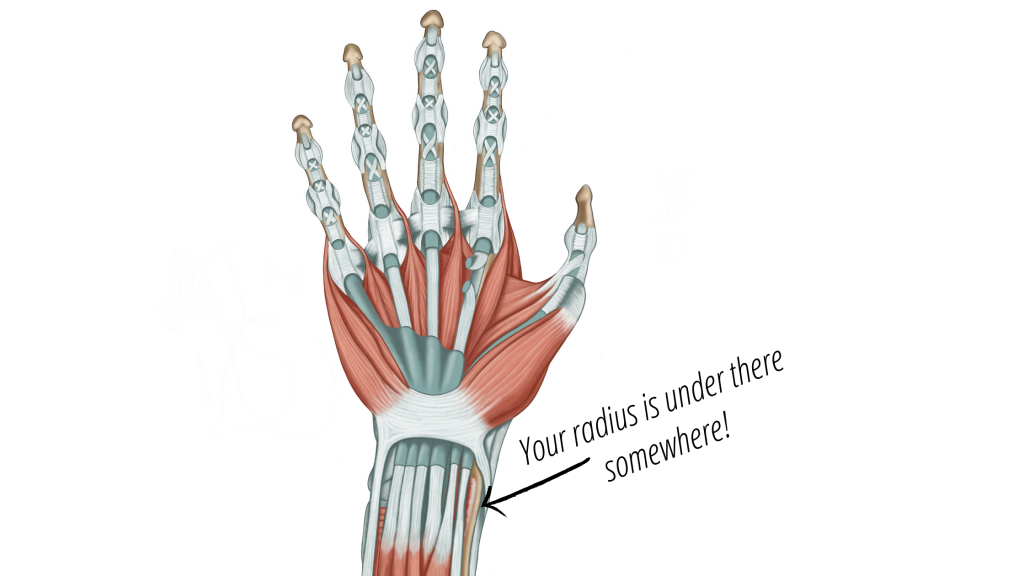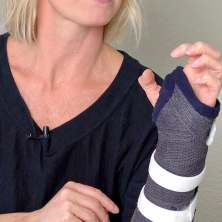One of the complications you may struggle with when healing from a broken wrist is bent, or curled fingers.
Your fingers become increasingly stiff while you wear your cast. And overtime, your fingers start to flex down, making straightening impossible.
So, why are my fingers curled after a broken wrist?
This is a common concern for people that have broken or injured their wrist. And probably the reason why you are searching for answers.
Curled fingers can prevent you from using your hand and fingers for daily activities, long after your wrist is healed.
In this blog post, I’ll guide you through 4 reasons why you may be dealing with curled fingers after a broken wrist, or wrist surgery.
On the other hand, I also want to help you prevent your fingers from bending, if you are starting to feel finger stiffness settling in.
First, it’s important to understand how the location of your injury, or fracture, affects your fingers.
The most common fracture in the wrist is a distal radius fracture. If this sounds familiar, you could have broken one of your long forearm bones where your wrist and hand meet.
On the palm side of your wrist and hand are several tendons that help you bend, or flex your fingers.
Your finger flexor tendons insert on your fingers, then travel over the front of your wrist. This allows you to bend your fingers and thumb.
On the other side of your wrist are more tendons. These are your extensor tendons, which allow you to straighten your fingers and thumb.
Basically both your finger flexor and finger extensor tendons cross over your broken wrist.
Reason #1: Curled Fingers After a Broken Wrist
Healing and Scar Tissue
As your broken wrist heals, your tendons that cross over that area can get very tight and basically stuck in the fracture healing.
And if you are not moving your flexor or extensor tendons very much, those tendons can become sandwiched between your fracture and your cast.
The same thing goes if you had wrist surgery to heal your broken wrist. Your tendons may stick to the scar tissue due to your incision.
This all happens on the palm side of your wrist and hand.
With your bone healing, you are usually wearing a splint or cast. With that often comes limited finger and wrist motion. This can cause your tendons to develop scar adhesions.
Overtime, as your wrist heals and your scar matures, your finger stiffness can worsen.
Your fingers can then become contracted down into a bent position.
Once that happens, you may notice straightening your fingers becomes increasingly difficult.
And your extensor tendons on the back of the hand don’t have enough strength to pull your fingers straight.
Therefore, a combination of scar tissue, bone healing, and lack of movement can cause your fingers to curl down.
Reason #2: Curled Fingers After a Broken Wrist
Swelling
Another reason why your fingers may be curled after a broken wrist is because of swelling.
It is very common after any kind of injury, or broken bone, to have a lot of extra fluid.
When you have a broken wrist, your fingers can swell up like sausages.
The fluid has to find somewhere to go. Usually that is on the back of your hand and fingers. The skin on the back of your hand is more elastic and wrinkly.
Wrinkles are good.
They allow us to flex our fingers… or any joint in our body.
Unfortunately, all that excess fluid takes up space and you lose your finger wrinkles.
Then your skin gets really tight.
The excess fluid begins to push your fingers forward. Over time, your ligaments, capsules, and joints get very tight.
Very quickly.
In fact, it just takes a few days for your ligaments to tighten up. After weeks of your fingers being swollen and tight…
That’s a recipe for having curled fingers after your broken wrist.
Reason #3: Curled Fingers After a Broken Wrist
Lack of Full Range Motion
Your doctor may have told you to move your fingers while your wrist was healing.
What most people think this means is wiggling their fingers.
I loathe when doctors do not explain the difference between wiggling and actually moving your fingers through your full range of motion. The reason for that is…
Wiggling is worthless.
I don’t mean for that to sound harsh. Wiggling in the early stages of healing can be very helpful and often all you can do.
However, wiggling only moves your fingers in a very limited range.
If wiggling is all you have been doing for several weeks then this is not enough to bend or straighten your fingers.
A lack of full range of motion day after day is guaranteed to make your fingers stiff.
Reason #4: Curled Fingers After a Broken Wrist
Resting Hand Posture is Flexed
Another reason why you might have curled fingers after a broken wrist is because the resting posture of your fingers is in a bent, or curled, position.
Just look at your fingers when your hand is relaxed. Your fingers naturally curl down.
When you have a cast, or a splint, you can’t really use your fingers normally. Plus you are likely very protective of your hand.
You could be avoiding any use or movement of your hand while you are doing daily tasks.
The worst part is your fingers are slightly bent more than they are straight.
Over days, or weeks, your fingers are staying curled for too long.
This piggybacks on my last reason. You haven’t moved through your full range of motion and kept your fingers very still.
You’re not doing exercises and you are not moving. Other than an occasional wiggle.
Your hand is constantly in a protected curled position for most of the day and night.
That’s why it is very important to make sure that you do finger mobility exercises daily, as prescribed by your doctor or therapist.
If you have not received any exercises, call your doctor.
In the meantime, check out my YouTube channel where I have many videos to help you get started.
Conclusion
By now you probably realize you have been doing one or more of the above. At least you know why your fingers are curled after a broken wrist. Now you know what to do about it.
I know it can be scary when your fingers are not moving. It is your hand and you want your fingers to work again.
Luckily, there are many stretches and exercises you can do to get your fingers moving normally.
For a demonstration of finger exercises that you can do in your cast check out this video here.
Then check out my Top 3 Finger Stiffness Exercises blog post. These exercises are gentle and a safe.
Of course, always check with your doctor before you start any kind of exercise program.
I hope you found this blog post helpful. If you did please share it with someone you know so they can prevent curled fingers after a broken wrist too!
Want freedom from stiff fingers and a weak grip?
Learn more about my Get A Grip Program, a simple self treatment system designed to improve your finger range of motion and strength without causing increased pain or swelling.









